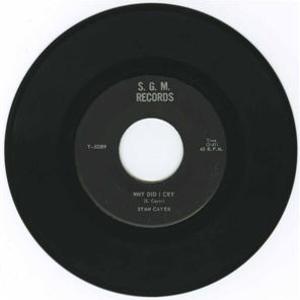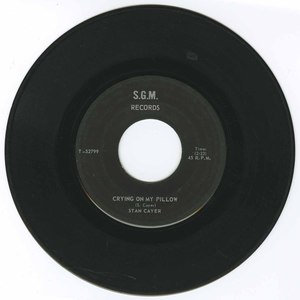Information/Write-up
Stan Cayer was a rockabilly singer, independent music mogul, and tireless promoter whose entrepreneurial energy helped shape Vancouver’s music scene in the 1960s and ’70s. A consummate self-starter, Cayer built his career by doing it all—writing, recording, producing, managing, pressing, promoting, and even performing under a pseudonym to get his foot in the door.
Born Stanley Gordon Melvin Cayer, he burst onto the scene in 1963 with a gutsy trip to Nashville, driving from Vancouver with $1,000 in cash sewn into his car seat. A devoted Elvis Presley fan, Cayer marched straight into RCA Studios and met with Bill Porter, Elvis’s longtime engineer. Porter agreed to record three of Cayer’s original songs, and hired an all-star Nashville lineup including Floyd Cramer, Boots Randolph, and Harold Bradley to back him. These songs—recorded live to three-track tape and mixed down to stereo masters—would launch Cayer’s indie empire.
While in Nashville, Cayer encountered Little Richard, who had been arrested on a public misconduct charge. With characteristic generosity (and a keen eye for a good story), Cayer bailed him out for $100—money that was never repaid. With his master tapes in hand, he returned to Vancouver and shopped them to various labels, turning down Jerden Records over contract concerns. Instead, he founded SGM Records—named after his initials—and his own publishing company, Astral Music Publishing.
Cayer’s first single, “3 Wild Women,” became a regional smash after he posed as his own manager, “Mel Gordon,” to gain an audience with Red Robinson at CFUN Radio. Initially dismissed as “just another Canadian,” Cayer won Robinson over by revealing the Nashville pedigree behind the track. The song hit the Top 10 in Vancouver and secured him a spot on CBC’s Let’s Go television show, where he performed Elvis covers five times between 1964 and 1965.
In 1964, he followed up with the Christmas single “Letter to Santa,” recorded at Robin Spurgin’s studio on Broadway, backed with “Crying on My Pillow” from the Nashville session. Realizing that the flip sides of his records were being overlooked, he issued a third single to spotlight the remaining tracks. Riding the momentum, Cayer launched a glossy teen magazine called Top Teen Scene, which featured The Beatles, James Brown, and other stars, alongside local radio station ads and concert photos taken by Cayer himself.
By 1965, Cayer had expanded his empire. Through SGM Records, he began signing and producing other artists, including The Shags, Bernard John & the Bats, and The In-Crowd—a short-lived group with future Collectors drummer Ross Turney and Chessmen bassist Larry Borisoff. In 1967, he formalized his artist management operations under Rols Royce Bookings, one of Vancouver’s first fully integrated indie booking agencies. To promote his roster, he released a four-track sampler EP featuring The Look, The Reign, The Silver Chalice Revue, and The Sound Set—a pioneering idea for the time, with picture sleeve and all.
Among his top priorities was the band Long Time Comin’, an offshoot of The Shags. Between 1970 and 1972, he produced a series of singles for them on SGM, including “Paper Rose” and “Downhill Slope,” some of which were distributed via London Records of Canada, giving his acts national exposure.
SGM flourished throughout the 1970s. Cayer released records by artists such as Sunday, David Sinclair, Cam Molloy, Flashlight, B. Jay Roberts, Beth Wright, and Marv Wilson. He also dabbled in country, gospel, and even radio/TV tie-ins, like the Daybreak LP for CHEK-TV. One memorable story involves gospel-soul singer Shirley Granger, who settled her SGM studio debt by transferring ownership of her 100-foot schooner, the Black Eyes, to Cayer. The vessel later appeared on the cover of her 1977 LP Amidst the Black Eyes—a surreal twist in a catalog full of oddball charm.
Later in life, Cayer invested heavily in real estate, ultimately achieving financial success outside the music industry. He was said to have died a wealthy man, having once owned that same 100-foot schooner and remaining a fixture of Vancouver’s local business scene until his death.
Stan Cayer passed away on October 16, 2016, after a battle with liver cancer. Though never a household name, his legacy runs deep in Canadian independent music. As an artist, entrepreneur, and tireless promoter, he left behind a unique catalog and a blueprint for how one person—with hustle and heart—could build an empire from scratch.
-Robert Williston



No Comments